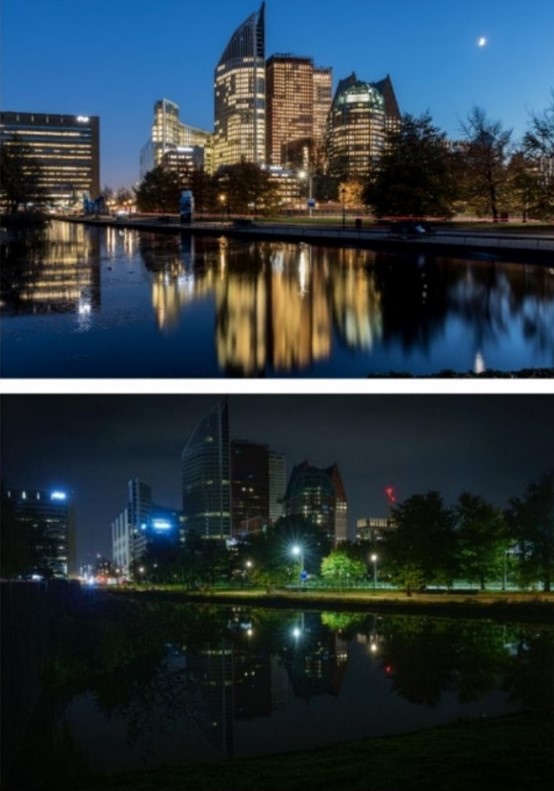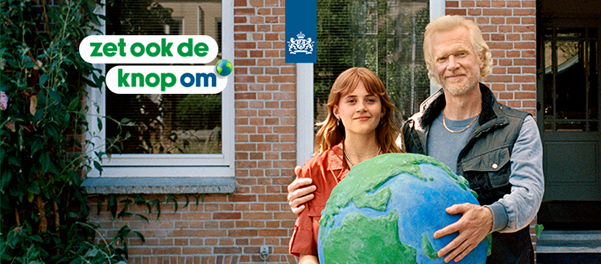Case Study Overview
The Dutch government launched the Flip the Switch (“Zet Ook De Knop Om”) campaign in spring 2022. The objective was to inform households and businesses about simple measures they could take to immediately save energy. Over time, the campaign was updated to include more comprehensive measures with a longer-term effect, including structural measures, financing, and personalised advice. The exemplary role of the public sector was also highlighted more explicitly in later stages of the campaign. Dutch citizens and businesses actively participated in energy saving activities, but it is difficult to disentangle the exact effect the campaign played in this behaviour change. From autumn 2023 onwards, the energy saving campaign became part of a broader climate and energy narrative, based on the same slogan “Flip the Switch”.
Design
Target audience: The target audience were Dutch citizens, but the campaign distinguished between households and small to medium enterprises as separate groups, to account for their varying information needs, measures they were able to take, and channels through which they were reached.
Objectives and message: The primary objective was to inform households and businesses about simple measures they can implement to save energy (gas), and to convince them to do so. A secondary objective was to raise awareness of the benefits of energy efficiency such as affordability, security, and sustainability more broadly.
Resources: The campaign was launched by the Ministry of Economic Affairs and Climate Policy. The core team consisted of several communications specialists and energy efficiency policy experts. The broader team included several other ministries and the Dutch enterprise agency. Every two weeks, the team met with representatives from industry associations, NGOs, and the Chamber of Commerce to align their campaigns, amplify the campaign’s message and hear their input.
The most important lesson: The public sector needs to lead by example for the message to be convincing to the general public. Impact analysis showed that early-on in the campaign citizens felt they were told to carry a burden without the government and the private sector playing their part. Subsequent phases of the campaign addressed this by showing the actions taken in each sector, such as turning down thermostats, turning off lighting and implementing structural efficiency measures in public buildings.
Implementation
 Media channels used: The campaign was launched with full-page ads in national newspapers, combined with radio, TV, and online media (Google, LinkedIn, X, Instagram). In all messaging, the target audience was reminded of the importance of saving energy and directed to a dedicated website for additional information, advice, and financing opportunities.
Media channels used: The campaign was launched with full-page ads in national newspapers, combined with radio, TV, and online media (Google, LinkedIn, X, Instagram). In all messaging, the target audience was reminded of the importance of saving energy and directed to a dedicated website for additional information, advice, and financing opportunities.
Recommended measures: Initially, the campaign gave three tips to households: turn the thermostat down to 19 degrees, turn off lighting in unused rooms, install LED lighting, and shower for five minutes maximum. Instead of shorter showers, it was recommended to companies to adjust Heating Ventilation and Air Conditioning (HVAC) systems to more efficient settings and to close external shop doors to retain heat inside. In later stages of the campaign, a wide range of measures was provided on the website, including energy efficiency renovations requiring upfront investment. An important addition was to describe for each measure how much money could be saved per year.
Stakeholder involvement: The campaign was designed in cooperation with public and private stakeholders. This made it simpler during the implementation phase to ask all stakeholders to amplify the campaign’s message and link their own communication messaging to the overall Flip the Switch one. As a result, the campaign’s reach was far larger than would have been possible with messaging from central government alone. Another interesting moment was the collaboration with “Night of the Night”, an initiative to turn off all lights one night. The Minister called on all municipalities to join in on this initiative, leading to a collective effort from the public sector to turn off lighting in well-known monuments such as the Erasmus bridge in Rotterdam and major city halls and ministries. The skyline of The Hague was similarly dark, sending a powerful signal about energy saving to the public.
The most important lesson: Engaging with different stakeholders to disseminate the message proved to be effective. People tend to trust the institutions they are in close contact with, these can be industry associations, NGOs, municipalities, hardware stores, and financial advisors so consulting with them to provide relevant information will improve the outcomes of the campaign.
Tracking
![]() Impacts: Most (57%) of the population recognised the campaign, although TV and radio dissemination were slightly less effective than in previous government campaigns. The perception of the campaign was largely positive and comparable to other government communication. However, the campaign is viewed as more aggravating than other campaigns as the target group increasingly believed the campaign did not provide new information.
Impacts: Most (57%) of the population recognised the campaign, although TV and radio dissemination were slightly less effective than in previous government campaigns. The perception of the campaign was largely positive and comparable to other government communication. However, the campaign is viewed as more aggravating than other campaigns as the target group increasingly believed the campaign did not provide new information.
Outcomes: In terms of primary objectives, significantly more households and businesses knew what they could do to save energy (gas) and implemented measures to reduce their energy consumption because of the campaign. Overall, 90% of Dutch citizens followed at least one recommended measure, such as turning down their thermostat and showering less than five minutes, and a large group did more than that. In terms of secondary objectives, households and businesses are more aware of the need to use less energy (gas), but the campaign did not increase this awareness level significantly. It remains challenging to disentangle the campaign’s effect from other factors such as price incentives.
From autumn 2023 onwards, the energy savings communication was integrated in a wider climate and energy campaign under the same “Flip the Switch” slogan. The new campaign provides information to the same two groups: households and businesses. However, information for households now also contains advice on (food) waste reduction, circularity, modal shifts in transport and recycling of materials along with energy efficiency. For companies, the information is broader on all financial support (grants and loans), legal obligations, advisory tools, and direct connections to their industry association on all things related to emissions and energy use reduction.
The most important lesson: It’s important to regularly update the campaign with new information and messaging, otherwise the target audience will grow tired of it. Surveys can help to identify when the information has reached saturation point, and it is time to update the campaign. Changing the recommendations based on the time of year and on the current energy situation (price levels, supply risks, recent events) is critical, as this will play into what is on people’s mind.
Campaign Summary
| Agency | Ministry of Economic Affairs and Climate Policy |
| Slogan | Flip the Switch (“Zet Ook De Knop Om”) |
| Website | www.zetookdeknopom.nl |
| Contact person | Suzanne van Yperen (s.a.z.vanyperen@minezk.nl) |


